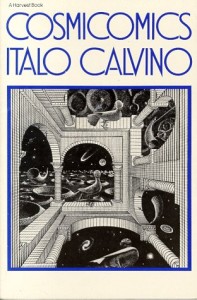 As I was reading Cosmicomics by Italo Calvino this weekend, I felt like the story “The Distance of the Moon” was somehow familiar. I had seen it—with my eyes, not in my imagination. But it wasn’t quite the same story. It took a few hours for me to remember that I was thinking of Pixar’s La Luna, the short film at the front of Brave.
As I was reading Cosmicomics by Italo Calvino this weekend, I felt like the story “The Distance of the Moon” was somehow familiar. I had seen it—with my eyes, not in my imagination. But it wasn’t quite the same story. It took a few hours for me to remember that I was thinking of Pixar’s La Luna, the short film at the front of Brave.
Sometimes I forget how much art and literature feed off one another. I shouldn’t because my writing is often inspired by other art forms. At this very moment, I am watching a random film and taking notes in a separate document on the interactions of the characters to help me understand the characters in my latest novel. But I was surprised (and delighted) to find something I consider to be relatively obscure had inspired a Pixar short.
Italo Calvino vs. Enrico Casarosa and Pixar
This could become a post about pop culture versus art, but I’d rather not make those distinctions, not today anyway. What interested me about the Calvino/Pixar relationship is that screenwriter Enrico Casarosa and Pixar were bringing this beautiful story of people rowing boats out into the sea to climb ladders onto a low-hanging moon to an audience who would mostly not read Calvino.
Though the setting of “The Distance of the Moon” and La Luna is the same and both are filled with childlike wonder, there are substantial differences between the stories. “The Distance of the Moon” is written for adults and in that wonderfully concise Calvino fashion, contains an undercurrent of sexuality and an allegory for unrequited love. The characters change from the page to the screen and the elements of danger and loss are omitted. Instead, Casarosa presents a film about family relationships and how the brightest ideas sometimes come from the youngest minds.
The Beauty of Variations
Chinese painters repaint masterpieces to learn the strokes of the masters who came before them. But can we ever create the same artwork or do we always leave a piece of ourselves behind?
I started thinking about “The Street of Crocodiles” by Bruno Schulz and the short film by the Brothers Quay (known for making music videos for Tool) of the same name. The story by Schulz is colorful and alive, whereas the film is truly creepy and compelling.
What I love about this process of iterative creation is that each new interpretation feels like rediscovering a story as each artist adds bits of themselves to the project.
Calvino and Schulz are inextricably linked in my reading habits. It’s like I’m locked in some Western European tapestry where Calvino creates the clean yet inventive geometry governing the weft while Schulz weaves and embroiders the warp with his crazy wild descriptions. It’s pretty awesome.
If this review made you want to read the book, pick up a copy of Cosmicomics from Powell’s Books. Your purchase keeps indie booksellers in business and I receive a commission.
